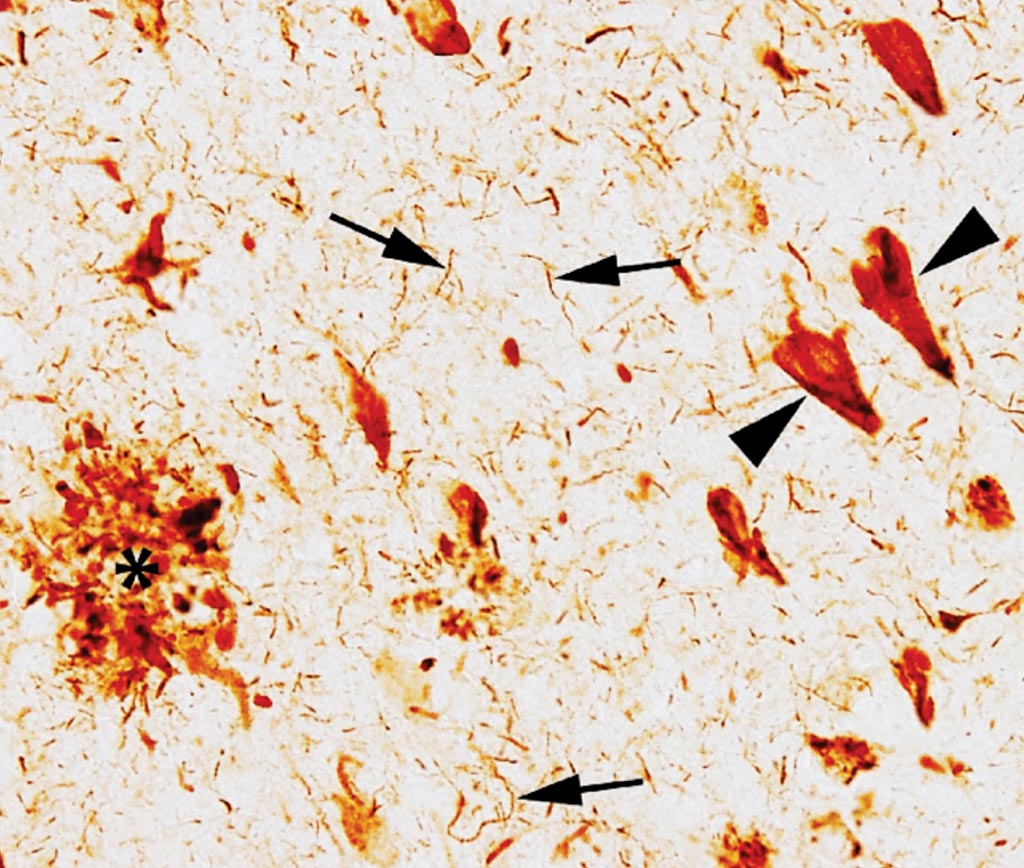Tau Blood Test Developed for Alzheimer's Disease
By LabMedica International staff writers
Posted on 17 Dec 2018
Presently, the only way to definitively diagnose Alzheimer's disease in life is through brain scans and tests of cerebrospinal fluid that must be collected via lumbar puncture. Though cumbersome and expensive, such tests provide the most accurate diagnoses for patients.Posted on 17 Dec 2018
The tau protein has long been implicated in Alzheimer’s; however, tau occurs as a family of related molecules, which have subtly different properties. Scientists have taken advantage of the complexity of tau and built assays to measure different forms of tau and identified a subset of tau proteins, which are specifically elevated in Alzheimer's disease.

Image: A section from the hippocampus of an Alzheimer’s disease patient stained with a tau antibody (TNT1). Note the classical triad of tau pathologies in AD, 1) neurofibrillary tangles (arrowheads), 2) neuropil threads (arrows), and 3) a neuritic plaque (asterisk) (Photo courtesy of Michigan State University).
A team of scientists working with those at Brigham and Women's Hospital (Boston, MA, USA) developed a set of immunoassays to measure tau in specimens from humans diagnosed based on current best clinical and cerebrospinal fluid (CSF) biomarker criteria. The developed tests were capable of detecting different populations of tau fragments in cerebrospinal fluid and blood. They applied these tests to participants who had been recruited to the Harvard Aging Brain Study as well as participants seen at the Institute of Neurology in London. Each participant donated both plasma and cerebrospinal fluid. They validated the results in a second group of patients that had been recruited.
The team analyzed five different tests for tau fragments, finding that one, known as the N-terminal (NT1) assay, showed sufficient diagnostic sensitivity (the ability to predict AD cases) and specificity (the ability to exclude controls) to pursue its use as a potential screening tool for Alzheimer's disease. This was confirmed in both sets of patients. In CSF, mid-region- and N-terminal-detected tau predominated and rose in disease. In plasma, an NT1 assay detected elevated levels of tau in AD and AD-mild cognitive impairment (MCI). Plasma NT1 measurements separated controls from AD-MCI and AD in a discovery cohort and in a validation cohort.
While performing the studies, twice, in two sets of patients with two different demographic backgrounds, provided important confirmation, the authors noted that both groups of participants were small (65 participants and 86 participants, respectively). The authors concluded that the forms of tau in CSF and plasma are distinct, but in each specimen type, the levels of certain fragments are increased in AD. Measurement of plasma NT1 tau should be aggressively pursued as a potential blood-based screening test for AD/AD-MCI.
Dominic M. Walsh, PhD, a Lecturer on Neurology and corresponding author of study said, “A blood test for Alzheimer's disease could be administered easily and repeatedly, with patients going to their primary care office rather than having to go into a hospital. Ultimately, a blood-based test could replace cerebrospinal fluid testing and/or brain imaging. Our new test has the potential to do just that. Our test will need further validation in many more people, but if it performs as in the initial two cohorts, it would be a transformative breakthrough.” The study was published on November 9, 2018, in the journal Alzheimer's & Dementia.
Related Links:
Brigham and Women's Hospital














